Analys
SEB – Råvarukommentarer, 17 mars 2015

Pessimisterna leder och dollarn blir ännu starkare
MARKNADEN I KORTHET
 Nästan alla korta positioner gick med vinst förra veckan (fredag till fredag) eftersom i princip alla råvaror gick ned i dollartermer. Dessutom försvagades kronan med 3 procent mot US dollar. Så de som hade ett kort råvarucertifikat förra veckan tjänade pengar både som ett resultat av råvaruprisfallet men också på grund av kronkursen. Dollarindex fortsatte upp med ett starkt 2,8 procent och sänkte förstås dollardenominerade råvaror. Den enda sektorn som steg i förra veckan var basmetaller som gick upp med 0,6 procent på grund av en 2 procents prisökning i koppar. Kinesisk statistik var blandad under veckan med negativa fundamenta i industriproduktion, investeringar och detaljhandelsförsäljning i början av veckan. Detta möttes dock av kinesiska data för utlåning och penningmängd som var bättre än väntat och förbättrade sentimentet för Kina något.
Nästan alla korta positioner gick med vinst förra veckan (fredag till fredag) eftersom i princip alla råvaror gick ned i dollartermer. Dessutom försvagades kronan med 3 procent mot US dollar. Så de som hade ett kort råvarucertifikat förra veckan tjänade pengar både som ett resultat av råvaruprisfallet men också på grund av kronkursen. Dollarindex fortsatte upp med ett starkt 2,8 procent och sänkte förstås dollardenominerade råvaror. Den enda sektorn som steg i förra veckan var basmetaller som gick upp med 0,6 procent på grund av en 2 procents prisökning i koppar. Kinesisk statistik var blandad under veckan med negativa fundamenta i industriproduktion, investeringar och detaljhandelsförsäljning i början av veckan. Detta möttes dock av kinesiska data för utlåning och penningmängd som var bättre än väntat och förbättrade sentimentet för Kina något.
Vinnare under förra veckan (mätt fredag till fredag) var de som hade en kort position i olja. Majkontraktet som våra certifikat följer för närvarande föll med nästan 9 procent, och den som investerade i certifikat noterade i kronor fick en extra skjuts av kronförsvagningen på ca 3 procent. Oljeoptimisterna som har pressat upp priset sedan slutet av januari fick vika sig förra veckan då amerikansk produktion av råolja såväl som lagren fortsatte att öka.
Den näst bästa positionen förra veckan var en kort position i kaffe, då majterminen föll drygt 7 procent i dollartermer. På tredje plats kom en kort position i socker, där majkontraktet föll med 5,5 procent. Även för kaffe och socker fick placeringar i certifikat noterade i kronor förstås en ännu bättre utveckling på grund av kronförsvagningen. Även guldpriset har fallit sedan rekommendationen av en kort position i förra veckan. Vi är fortfarande negativa till guld och ligger därför kvar med vår rekommendation.
TRENDER I SAMMANDRAG
- Brentolja negativ. Optimisterna har lagt sig. Amerikansk produktion och lager fortsätter obönhörligen högre och WTI har nått nivåer under lägstanivåerna för januari, och vi måste se tillbaka ända till 2009 för att se jämförbara nivåer. WTI råolja ser ut att kunna handlas under 40 USD/fat och kommer dra med Brentoljan ned under 50 USD/fat (jämfört med nuvarande dryga 53 USD/fat).
- Kaffe ser fortfarande svagt ut både fundamentalt och tekniskt även om vi såg en rekyl uppåt den 16 mars då priset steg med 6,7 procent på grund av att korta positioner täcktes.
- Socker är i en ordentlig nedåttrend som vi tror kommer att hålla i sig och vi förväntar oss ännu lägre priser.
- US dollar befinner sig i ett episkt rally. Vi förväntar oss ytterligare förstärkning. Detta kommer att pressa ner priset på råvaror i dollartermer. Vi rekommenderar därför även en placering i valutacertifikat USDSEK S.
REKOMMENDATIONER

En placering i certifikat och warranter är förknippat med risker. Du kan förlora hela ditt investerade kapital. Läs mer om riskerna i SEB:s offentliggjorda Grundprospekt för certifikat- och warrantprogram på seb.se/cert eller seb.se/mini.
OLJA
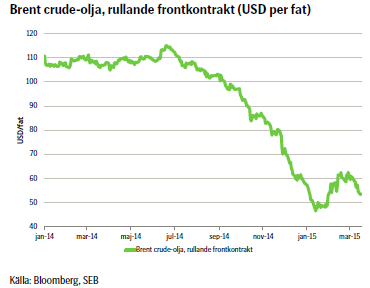 Det är kritiskt läge för WTI den närmaste månaden medan amerikansk råoljeproduktion och råoljelager fortsätter att växa. ”Oljeoptimisterna” lyckades trycka både Brentoljan och WTI in i ett rally som började i slutet av januari. Detta rally är nu över. Fundamenta har tagit över och pressar priset nedåt igen. De som har trott på en uppgång viker sig nu och tar sina förluster och WTI är nere på nya lägstanivåer för året (42,85 USD/fat) – priser som inte har setts sedan 2009. Under de närmaste veckorna och månaderna kommer WTI antagligen att handla under 40 USD/fat och Brentoljan kommer att dras med ner till under 50 USD/fat (handlas för närvarande runt 53,50 USD/fat). Vi är nu mitt i den svagaste delen av året. Raffinaderier kommer att i ökad utsträckning stänga för underhåll i Europa och Asien och detta kommer att leda till minskad efterfrågan på olja utanför USA. Detta skapar ofta en prismässig svaghet för Brentoljan.
Det är kritiskt läge för WTI den närmaste månaden medan amerikansk råoljeproduktion och råoljelager fortsätter att växa. ”Oljeoptimisterna” lyckades trycka både Brentoljan och WTI in i ett rally som började i slutet av januari. Detta rally är nu över. Fundamenta har tagit över och pressar priset nedåt igen. De som har trott på en uppgång viker sig nu och tar sina förluster och WTI är nere på nya lägstanivåer för året (42,85 USD/fat) – priser som inte har setts sedan 2009. Under de närmaste veckorna och månaderna kommer WTI antagligen att handla under 40 USD/fat och Brentoljan kommer att dras med ner till under 50 USD/fat (handlas för närvarande runt 53,50 USD/fat). Vi är nu mitt i den svagaste delen av året. Raffinaderier kommer att i ökad utsträckning stänga för underhåll i Europa och Asien och detta kommer att leda till minskad efterfrågan på olja utanför USA. Detta skapar ofta en prismässig svaghet för Brentoljan.
Vi är negativa till oljepriset för närvarande. Det kommer en vändning på sikt, men vi är inte där ännu.
TREND
- Det är kritiskt läge för WTI och Brentoljan dras med ned
- Lägre efterfrågan på råolja från raffinaderier i Europa och Asien i april och maj på grund av underhållsarbete
- OPEC fortsätter att producera 30,2 miljoner fat per dag, vilket är över ”taket” och över behovet. Behovet av OPEC olja under andra kvartalet 2015 är bara 28,5 miljoner fat per dag
- Vi tror att Brentoljan kommer att handlas under 50 USD/fat i närtid.
REKOMMENDATION
- BEAR OLJA X1 S
KAFFE
Utvecklingen i kaffepriset är intressant; inte minst på grund av sin stora rörelse under 2014. Låt oss därför se litet närmare på priset för Arabica-kaffe: Mellan 2011 och 2014 såg vi en klar och tydlig nedåtgående trend vad gäller terminpriset, men det fick ett abrupt slut på grund av kraftig torka i Brasilien samt svampangrepp på plantor i Centralamerika. Efter att det regnade i områden med just kaffeproduktion hämtade sig skörden, åtminstone delvis och priset har fallit sedan slutet av 2014. Bara sedan årsskiftet har det fallit drygt 20 procent och med hela 40 procent sedan den högsta noteringen under 2014. Över förra veckan (fredag till fredag) är samma notering drygt -7 procent. De brasilianska skördarna överraskat på uppsidan efter torkan, även om vissa bedömare tror att det blir ett bortfall motsvarande ungefär 1,5 procent av världens totala kaffeproduktion. Sammantaget ser vi nu en kraftig korrektion nedåt på priset mot den trend vi såg innan torkan i Brasilien.
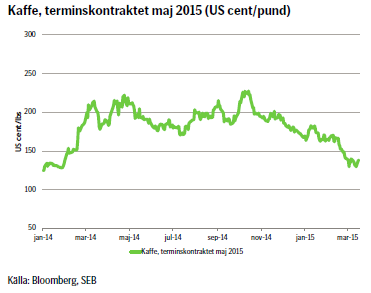 Finansiellt har de långa nettopositionerna minskat kraftigt och terminskurvan har skiftat inåt över det senaste året. Den brasilianska realen har försvagats tämligen kraftigt mot dollarn och det finns en stark korrelation mellan den svagare valutan och ett lägre kaffepris. Förklaringen är att bönder i Brasilien har fått relativt bättre betalt, sålt mer, exporten har ökat och det har blivit press nedåt på priset.
Finansiellt har de långa nettopositionerna minskat kraftigt och terminskurvan har skiftat inåt över det senaste året. Den brasilianska realen har försvagats tämligen kraftigt mot dollarn och det finns en stark korrelation mellan den svagare valutan och ett lägre kaffepris. Förklaringen är att bönder i Brasilien har fått relativt bättre betalt, sålt mer, exporten har ökat och det har blivit press nedåt på priset.
Även tekniskt ser vi ett fortsatt nedåttryck och för att bryta detta behöver priset stiga ända till 162,15 US cent per pund. Sedan förra veckan har säljtrycket mattats något, men det underliggande vågmönstret gör att vi tror att det kommer att fortsätta, med nästa stöd nedåt vid 119,02 US dollar per pund.
TREND
- Fundamentala faktorer talar för press nedåt på priset
- Tekniska faktorer talar också för ett fall mot stödet 119,02 US cent per pund
- Vi tror att kaffepriset kommer röra sig nedåt på kort sikt.
REKOMMENDATION
- BEAR KAFFE X5 S
SOCKER
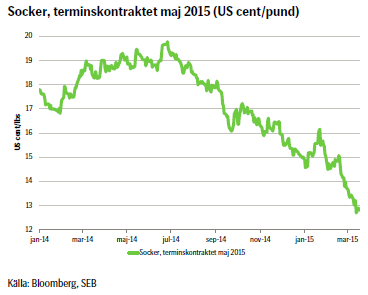 Vår vy om en kort position i socker har gett oss fortsatt utdelning. Under fredagens handel föll priset på ICE med nästan 4 procent för att notera den lägsta nivån på 6 år. Samtidigt så fick topp producenten Brasilien se sin valuta real sjunka till den lägsta nivån mot dollarn på 12 år under veckans sista handelsdag. Det brasilianska konsultföretaget AgroConsult justerar upp sin prognos för produktionen av sockerrör 2015/16 med 20 miljoner ton till 620 miljoner ton i regionen Centrum Syd, som står för 90 procent av landets produktion.
Vår vy om en kort position i socker har gett oss fortsatt utdelning. Under fredagens handel föll priset på ICE med nästan 4 procent för att notera den lägsta nivån på 6 år. Samtidigt så fick topp producenten Brasilien se sin valuta real sjunka till den lägsta nivån mot dollarn på 12 år under veckans sista handelsdag. Det brasilianska konsultföretaget AgroConsult justerar upp sin prognos för produktionen av sockerrör 2015/16 med 20 miljoner ton till 620 miljoner ton i regionen Centrum Syd, som står för 90 procent av landets produktion.
TREND
- Så länge priset inte bryter igenom det tekniska motståndet på 13,21 US cent så fortsätter vi med en kort position och håller ett öga på om marknaden kan hitta en stödnivå ner mot 12 US cent.
REKOMMENDATION
- BEAR SOCKER X 1 S
BASMETALLER – ALUMINIUM & ZINK
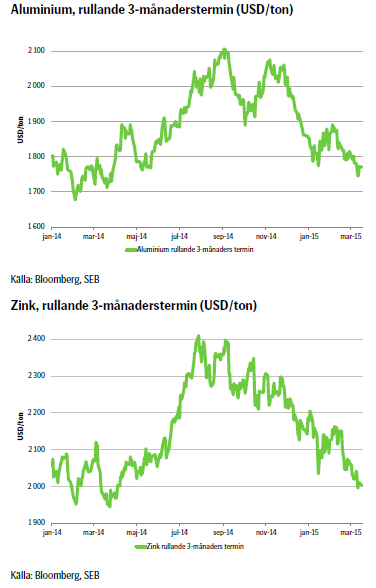 Fokus under veckan har legat på den fortsatt starka dollarn. Den starka arbetsmarknadsstatistiken veckan före i kombination med de påbörjade obligationsköpen i Europa har pressat EUR/SEK kontinuerligt ned mot 1,05. Den negativa korrelationen mot de dollarnoterade metallerna gör sig gällande. Intressant att notera den senaste veckan att priserna håller emot bättre. Räknat i Euro och SEK är priserna på relativt höga nivåer. Till exempel zink handlas på den högsta nivån sedan maj 2010. I veckan som gick är uppgången ca 2,5 procent för zink och aluminium som vi har bevakat de senaste veckorna. Priserna har dock fallit tillbaka räknat i den noterade valutan USD. Vi bedömer dock att nedgången inte riktigt speglar den fundamentala situationen fullt ut. En stabilisering av dollar skulle enligt vår mening lätta på trycket och sannolikt stärka priserna ytterligare. Vi kvarstår med tidigare bedömning om en starkare prisbild under andra kvartalet 2015.
Fokus under veckan har legat på den fortsatt starka dollarn. Den starka arbetsmarknadsstatistiken veckan före i kombination med de påbörjade obligationsköpen i Europa har pressat EUR/SEK kontinuerligt ned mot 1,05. Den negativa korrelationen mot de dollarnoterade metallerna gör sig gällande. Intressant att notera den senaste veckan att priserna håller emot bättre. Räknat i Euro och SEK är priserna på relativt höga nivåer. Till exempel zink handlas på den högsta nivån sedan maj 2010. I veckan som gick är uppgången ca 2,5 procent för zink och aluminium som vi har bevakat de senaste veckorna. Priserna har dock fallit tillbaka räknat i den noterade valutan USD. Vi bedömer dock att nedgången inte riktigt speglar den fundamentala situationen fullt ut. En stabilisering av dollar skulle enligt vår mening lätta på trycket och sannolikt stärka priserna ytterligare. Vi kvarstår med tidigare bedömning om en starkare prisbild under andra kvartalet 2015.
TREND
- I takt med att den fundamentala balansen förbättras bedöms priserna på aluminium och zink succesivt stärkas under året.
- Flera gruvstängningar i år och nästa, kommer inte fullt ut att ersättas. Risk för brist 2016 (zink).
- Efterfrågan på aluminium har ökat 4-7 % den senaste 3-4 åren, en trend som förväntas fortsätta.
REKOMMENDATION
- ALUMINIUM S och ZINK S
[box]SEB Veckobrev Veckans råvarukommentar är producerat av SEB:s Commodities Sales desk och publiceras i samarbete och med tillstånd på Råvarumarknaden.se[/box]
KÄLLOR
Bloomberg, Reuters, SEB
VILLKOR
För varje enskilt certifikat/mini future finns Slutliga Villkor som anger de fullständiga villkoren. Slutliga Villkor finns tillgängligt på kurssidan för respektive certifikat/mini future på www.seb.se, Börs & finans, fliken Strukturerade placeringar.
RISKER
En sammanfattning av de risker som är förknippade med Börshandlade certifikat generellt finns i Produktbroschyren för respektive certifikat eller mini future som är tillgängligt på seb.se/cert respektive seb.se/mini. För en fullständig bild av riskerna behöver du ta del av SEB:s offentliggjorda Grundprospekt för Certifikat- och Warrantprogram som är publicerat på www.seb.se/cert respektive seb.se/mini.
DISCLAIMER
Detta marknadsföringsmaterial, framtaget av SEB:s Commodities Sales desk, har upprättats enbart i informationssyfte.
Även om innehållet är baserat på källor som SEB bedömt som tillförlitliga ansvarar SEB inte för fel eller brister i informationen. Den utgör inte oberoende, objektiv investeringsanalys och skyddas därför inte av de bestämmelser som SEB har infört för att förebygga potentiella intressekonflikter. Yttranden från SEB:s Commodities Sales desk kan vara oförenliga med tidigare publicerat material från SEB, då den senare hänvisas uppmanas du att läsa den fullständiga rapporten innan någon åtgärd vidtas.
Dokumentationen utgör inte någon investeringsrådgivning och tillhandahålls till dig utan hänsyn till dina investeringsmål. Du uppmanas att självständigt bedöma och komplettera uppgifterna i denna dokumentation och att basera dina investeringsbeslut på material som bedöms erforderligt. Alla framåtblickande uttalanden, åsikter och förväntningar är föremål för risker, osäkerheter och andra faktorer och kan orsaka att det faktiska resultatet avviker väsentligt från det förväntade. Historisk avkastning är ingen garanti för framtida resultat. Detta dokument utgör inte ett erbjudande att teckna några värdepapper eller andra finansiella instrument. SEB svarar inte för förlust eller skada – direkt eller indirekt, eller av vad slag det vara må – som kan uppkomma till följd av användandet av detta material eller dess innehåll.
Observera att det kan förekomma att SEB, dess ledamöter, dess anställda eller dess moder- och/eller dotterbolag vid olika tillfällen innehar, har innehaft eller kommer att inneha aktier, positioner, rådgivningsuppdrag i samband med corporate finance-transaktioner, investment- eller merchantbanking-uppdrag och/eller lån i de bolag/finansiella instrument som nämns i materialet.
Materialet är avsett för mottagaren, all spridning, distribuering mångfaldigande eller annan användning av detta meddelande får inte ske utan SEB:s medgivande. Materialet riktar sig inte till personer vars medverkan kräver ytterligare prospekt, registrerings- eller andra åtgärder än vad som följer av svensk rätt. Det åligger var och en att iaktta sådana restriktioner. Materialet får inte distribueras i eller till land där distribution kräver ovan nämnda åtgärder eller strider mot reglering i sådant land. Materialet riktar sig således inte till fysiska eller juridiska personer hemmahörande i USA eller i något annat land där publicering eller tillhandahållande av materialet är förbjudet eller strider mot tillämpliga bestämmelser i landet.
Oaktat detta får SEB tillåta omfördelning av materialet till utvald tredje part i enlighet med gällande avtal. Materialet får inte spridas till fysiska eller juridiska personer som är medborgare eller har hemvist i ett land där sådan spridning är otillåten enligt tillämplig lag eller annan bestämmelse.
Skandinaviska Enskilda Banken AB (publ) är ett publikt aktiebolag och står under tillsyn av Finansinspektionen samt de lokala finansiella tillsynsmyndigheter i varje jurisdiktionen där SEB har filial eller dotterbolag.
Analys
’wait and see’ mode

So far this week, Brent Crude prices have strengthened by USD 1.3 per barrel since Monday’s opening. While macroeconomic concerns persist, they have somewhat abated, resulting in muted price reactions. Fundamentals predominantly influence global oil price developments at present. This week, we’ve observed highs of USD 89 per barrel yesterday morning and lows of USD 85.7 per barrel on Monday morning. Currently, Brent Crude is trading at a stable USD 88.3 per barrel, maintaining this level for the past 24 hours.

Additionally, there has been no significant price reaction to Crude following yesterday’s US inventory report (see page 11 attached):
- US commercial crude inventories (excluding SPR) decreased by 6.4 million barrels from the previous week, standing at 453.6 million barrels, roughly 3% below the five-year average for this time of year.
- Total motor gasoline inventories decreased by 0.6 million barrels, approximately 4% below the five-year average.
- Distillate (diesel) inventories increased by 1.6 million barrels but remain weak historically, about 7% below the five-year average.
- Total commercial petroleum inventories (crude + products) decreased by 3.8 million barrels last week.
Regarding petroleum products, the overall build/withdrawal aligns with seasonal patterns, theoretically exerting limited effect on prices. However, the significant draw in commercial crude inventories counters the seasonality, surpassing market expectations and API figures released on Tuesday, indicating a draw of 3.2 million barrels (compared to Bloomberg consensus of +1.3 million). API numbers for products were more in line with the US DOE.
Against this backdrop, yesterday’s inventory report is bullish, theoretically exerting upward pressure on crude prices.
Yet, the current stability in prices may be attributed to reduced geopolitical risks, balanced against demand concerns. Markets are adopting a wait-and-see approach ahead of Q1 US GDP (today at 14:30) and the Fed’s preferred inflation measure, “core PCE prices” (tomorrow at 14:30). A stronger print could potentially dampen crude prices as market participants worry over the demand outlook.
Geopolitical “risk premiums” have decreased from last week, although concerns persist, highlighted by Ukraine’s strikes on two Russian oil depots in western Russia and Houthis’ claims of targeting shipping off the Yemeni coast yesterday.
With a relatively calmer geopolitical landscape, the market carefully evaluates data and fundamentals. While the supply picture appears clear, demand remains the predominant uncertainty that the market attempts to decode.
Analys
Also OPEC+ wants to get compensation for inflation

Brent crude has fallen USD 3/b since the peak of Iran-Israel concerns last week. Still lots of talk about significant Mid-East risk premium in the current oil price. But OPEC+ is in no way anywhere close to loosing control of the oil market. Thus what will really matter is what OPEC+ decides to do in June with respect to production in Q3-24 and the market knows this very well. Saudi Arabia’s social cost-break-even is estimated at USD 100/b today. Also Saudi Arabia’s purse is hurt by 21% US inflation since Jan 2020. Saudi needs more money to make ends meet. Why shouldn’t they get a higher nominal pay as everyone else. Saudi will ask for it

Brent is down USD 3/b vs. last week as the immediate risk for Iran-Israel has faded. But risk is far from over says experts. The Brent crude oil price has fallen 3% to now USD 87.3/b since it became clear that Israel was willing to restrain itself with only a muted counter attack versus Israel while Iran at the same time totally played down the counterattack by Israel. The hope now is of course that that was the end of it. The real fear has now receded for the scenario where Israeli and Iranian exchanges of rockets and drones would escalate to a point where also the US is dragged into it with Mid East oil supply being hurt in the end. Not everyone are as optimistic. Professor Meir Javedanfar who teaches Iranian-Israeli studies in Israel instead judges that ”this is just the beginning” and that they sooner or later will confront each other again according to NYT. While the the tension between Iran and Israel has faded significantly, the pain and anger spiraling out of destruction of Gaza will however close to guarantee that bombs and military strifes will take place left, right and center in the Middle East going forward.
Also OPEC+ wants to get paid. At the start of 2020 the 20 year inflation adjusted average Brent crude price stood at USD 76.6/b. If we keep the averaging period fixed and move forward till today that inflation adjusted average has risen to USD 92.5/b. So when OPEC looks in its purse and income stream it today needs a 21% higher oil price than in January 2020 in order to make ends meet and OPEC(+) is working hard to get it.
Much talk about Mid-East risk premium of USD 5-10-25/b. But OPEC+ is in control so why does it matter. There is much talk these days that there is a significant risk premium in Brent crude these days and that it could evaporate if the erratic state of the Middle East as well as Ukraine/Russia settles down. With the latest gains in US oil inventories one could maybe argue that there is a USD 5/b risk premium versus total US commercial crude and product inventories in the Brent crude oil price today. But what really matters for the oil price is what OPEC+ decides to do in June with respect to Q3-24 production. We are in no doubt that the group will steer this market to where they want it also in Q3-24. If there is a little bit too much oil in the market versus demand then they will trim supply accordingly.
Also OPEC+ wants to make ends meet. The 20-year real average Brent price from 2000 to 2019 stood at USD 76.6/b in Jan 2020. That same averaging period is today at USD 92.5/b in today’s money value. OPEC+ needs a higher nominal price to make ends meet and they will work hard to get it.
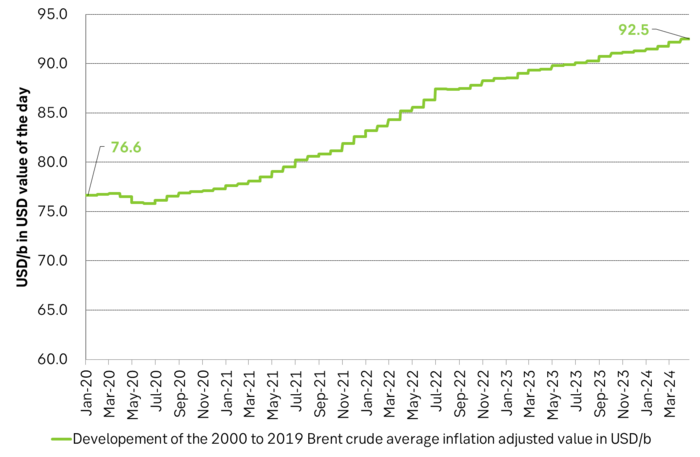
Inflation adjusted Brent crude price versus total US commercial crude and product stocks. A bit above the regression line. Maybe USD 5/b risk premium. But type of inventories matter. Latest big gains were in Propane and Other oils and not so much in crude and products

Total US commercial crude and product stocks usually rise by 4-5 m b per week this time of year. Gains have been very strong lately, but mostly in Propane and Other oils

Last week’s US inventory data. Big rise of 10 m b in commercial inventories. What really stands out is the big gains in Propane and Other oils
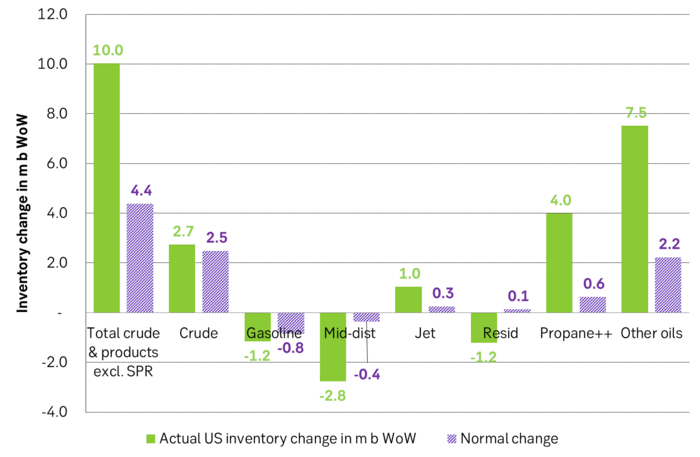
Take actual changes minus normal seasonal changes we find that US commercial crude and regular products like diesel, gasoline, jet and bunker oil actually fell 3 m b versus normal change.

Analys
Nat gas to EUA correlation will likely switch to negative in 2026/27 onward

Historically positive Nat gas to EUA correlation will likely switch to negative in 2026/27 onward

Historically there has been a strong, positive correlation between EUAs and nat gas prices. That correlation is still fully intact and possibly even stronger than ever as traders increasingly takes this correlation as a given with possible amplification through trading action.
The correlation broke down in 2022 as nat gas prices went ballistic but overall the relationship has been very strong for quite a few years.
The correlation between nat gas and EUAs should be positive as long as there is a dynamical mix of coal and gas in EU power sector and the EUA market is neither too tight nor too weak:
Nat gas price UP => ”you go black” by using more coal => higher emissions => EUA price UP
But in the future we’ll go beyond the dynamically capacity to flex between nat gas and coal. As the EUA price moves yet higher along with a tightening carbon market the dynamical coal to gas flex will max out. The EUA price will then trade significantly above where this flex technically will occur. There will still be quite a few coal fired power plants running since they are needed for grid stability and supply amid constrained local grids.
As it looks now we still have such overall coal to gas flex in 2024 and partially in 2025, but come 2026 it could be all maxed out. At least if we look at implied pricing on the forward curves where the forward EUA price for 2026 and 2027 are trading way above technical coal to gas differentials. The current forward pricing implications matches well with what we theoretically expect to see as the EUA market gets tighter and marginal abatement moves from the power sector to the industrial sector. The EUA price should then trade up and way above the technical coal to gas differentials. That is also what we see in current forward prices for 2026 and 2027.
The correlation between nat gas and EUAs should then (2026/27 onward) switch from positive to negative. What is left of coal in the power mix will then no longer be dynamically involved versus nat gas and EUAs. The overall power price will then be ruled by EUA prices, nat gas prices and renewable penetration. There will be pockets with high cost power in the geographical points where there are no other alternatives than coal.
The EUA price is an added cost of energy as long as we consume fossil energy. Thus both today and in future years we’ll have the following as long as we consume fossil energy:
EUA price UP => Pain for consumers of energy => lower energy consumption, faster implementation of energy efficiency and renewable energy => lower emissions
The whole idea with the EUA price is after all that emissions goes down when the EUA price goes up. Either due to reduced energy consumption directly, accelerated energy efficiency measures or faster switch to renewable energy etc.
Let’s say that the coal to gas flex is maxed out with an EUA price way above the technical coal to gas differentials in 2026/27 and later. If the nat gas price then goes up it will no longer be an option to ”go black” and use more coal as the distance to that is too far away price vise due to a tight carbon market and a high EUA price. We’ll then instead have that:
Nat gas higher => higher energy costs with pain for consumers => weaker nat gas / energy demand & stronger drive for energy efficiency implementation & stronger drive for more non-fossil energy => lower emissions => EUA price lower
And if nat gas prices goes down it will give an incentive to consume more nat gas and thus emit more CO2:
Cheaper nat gas => Cheaper energy costs altogether, higher energy and nat gas consumption, less energy efficiency implementations in the broader economy => emissions either goes up or falls slower than before => EUA price UP
Historical and current positive correlation between nat gas and EUA prices should thus not at all be taken for granted for ever and we do expect this correlation to switch to negative some time in 2026/27.
In the UK there is hardly any coal left at all in the power mix. There is thus no option to ”go black” and burn more coal if the nat gas price goes up. A higher nat gas price will instead inflict pain on consumers of energy and lead to lower energy consumption, lower nat gas consumption and lower emissions on the margin. There is still some positive correlation left between nat gas and UKAs but it is very weak and it could relate to correlations between power prices in the UK and the continent as well as some correlations between UKAs and EUAs.
Correlation of daily changes in front month EUA prices and front-year TTF nat gas prices, 250dma correlation.
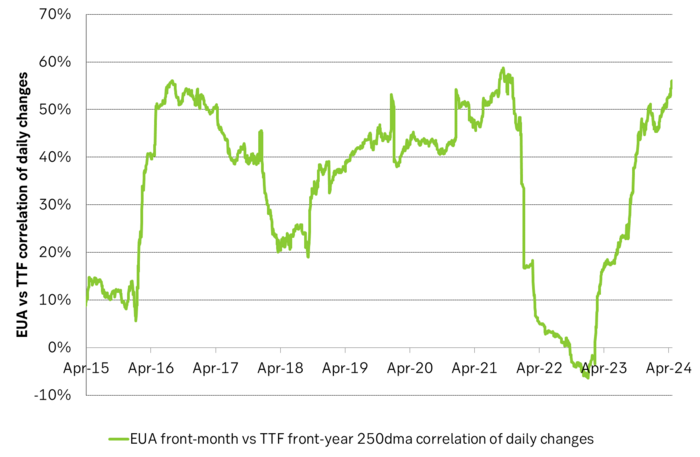
EUA price vs front-year TTF nat gas price since March 2023
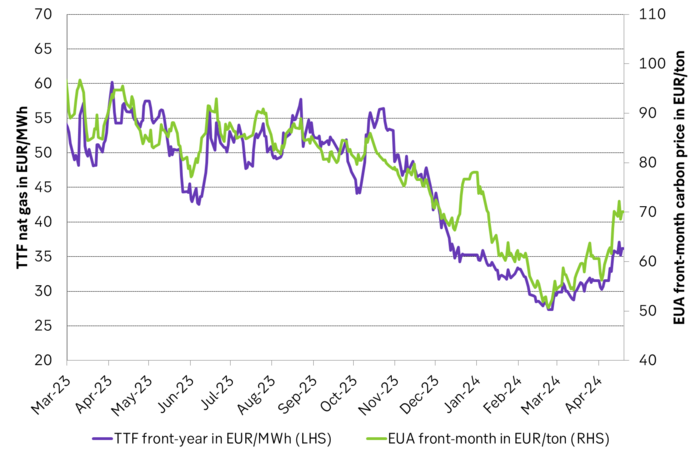
Front-month EUA price vs regression function of EUA price vs. nat gas derived from data from Apr to Nov last year.
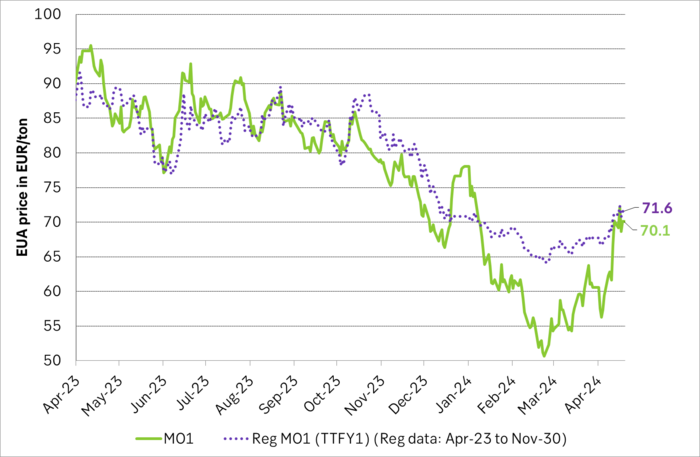
The EUA price vs the UKA price. Correlations previously, but not much any more.
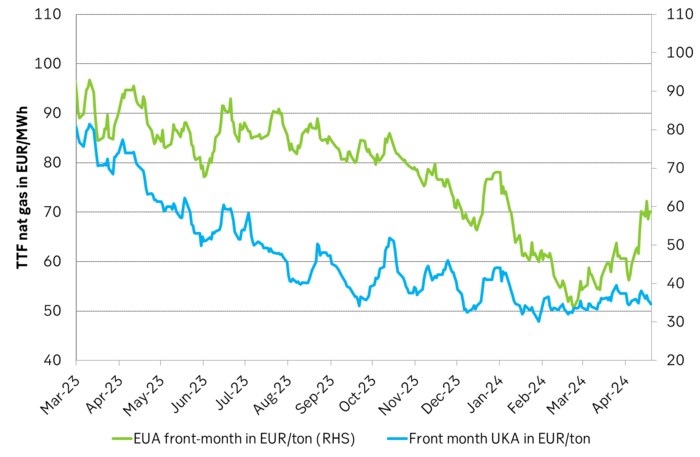
Forward German power prices versus clean cost of coal and clean cost of gas power. Coal is totally priced out vs power and nat gas on a forward 2026/27 basis.

Forward price of EUAs versus technical level where dynamical coal to gas flex typically takes place. EUA price for 2026/27 is at a level where there is no longer any price dynamical interaction or flex between coal and nat gas. The EUA price should/could then start to be negatively correlated to nat gas.

Forward EAU price vs. BNEF base model run (look for new update will come in late April), SEB’s EUA price forecast.
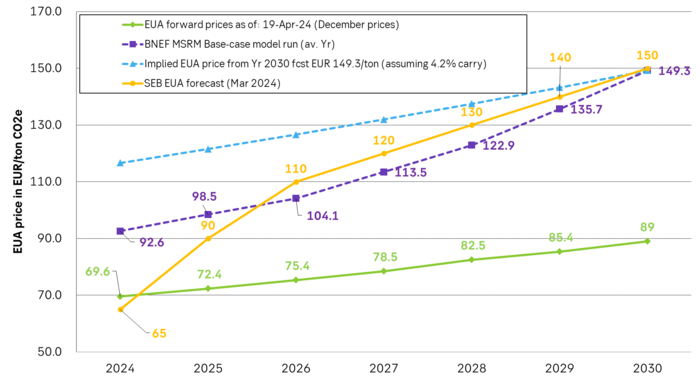
-

 Nyheter3 veckor sedan
Nyheter3 veckor sedanGuldpriset når nytt all time high och bryter igenom 2300 USD
-

 Nyheter3 veckor sedan
Nyheter3 veckor sedanUSAs stigande konsumtion av naturgas
-

 Nyheter3 veckor sedan
Nyheter3 veckor sedanCentralbanker fortsatte att köpa guld under februari
-

 Nyheter3 veckor sedan
Nyheter3 veckor sedanKakaomarknaden är extrem för tillfället
-

 Nyheter3 veckor sedan
Nyheter3 veckor sedanHur mår den svenska skogsbraschen? Två favoritaktier
-

 Nyheter4 veckor sedan
Nyheter4 veckor sedanBoliden på 20 minuter
-

 Nyheter3 veckor sedan
Nyheter3 veckor sedanBetydande underskott i utbudet av olja kan få priset att blossa upp
-

 Nyheter4 veckor sedan
Nyheter4 veckor sedanMyten om guld – Den magiska metallen född från stjärnstoft








